Recently updated on: October 29th, 2024
Today’s natural products are not only based on plant extracts and their ingredients. A novelty in the industry are plant stem cells – obtained in vitro and characterized by strong regenerative properties. What are these cells and how to use their potential?
Plant stem cells – what are they?
Stem cells are found in all living organisms – in humans, animals and plants. They are non-specialized cells with unique regenerative abilities that the cell maintains throughout its life cycle, as well as with the ability to differentiate into specialized cell types.
In plants, they are found primarily in the germinating seeds, plant stem and root – more specifically in the areas called meristems. These are small cells with embryonic characteristics, which are responsible for rebuilding parts of or the entire plant. Their features include:
- extended cell cycle – lower rate of cell division,
- extended cell cycle – lower rate of cell division,
- unlimited ability to self-renew (regenerative capacity),
- state of metabolic dormancy.
How are plant stem cells obtained?
Typically, plant stem cells are isolated from areas of meristematic tissues and then replicated in vitro in cell cultures, by way of micropropagation. By incising a selected part of the plant, the development of a callus is induced. Callus is also called appendage tissue: it is a mass of undifferentiated and rapidly dividing cells produced at the site where the wound was created in the plant, which transform into stem cells. The cells are then cultured in special bioreactors for the production of plant stem cell extracts.
The principal advantage of culturing stem cells under laboratory conditions is the ability to prepare extracts rich in selected desired secondary metabolites – the biologically active compounds responsible for the extract’s properties. While plant cultures themselves usually contain scarce amounts of these substances, through culturing it is possible to stimulate cells to produce them in greater quantities, as well as engineer the process to produce specific substances. For this purpose, undifferentiated cell culture is treated with elicitors – agents that induce biochemical plant defense reactions and, consequently, increased production of compounds responsible for the medicinal properties of the extract, including polyphenols, phenolic acids, flavonoids, triterpenes and carotenoids.
How do plant stem cells work?
Thanks to their unique properties, plant stem cells are an innovative ingredient, widely researched for its possible applications – especially in the context of their effect on human skin. The substances they contain affect – directly or indirectly – the process of delaying skin aging and show properties that stimulate the stem cells of human epidermis and dermis to divide. Numerous studies confirm that plant stem cell extracts can have beneficial effects on the skin, including by way of:
- protecting stem cells against free radicals and toxic substances,
- enhancing stem cells’ repair capacities,
- counteracting the formation of discoloration blemishes, by protecting melanocytes from UV radiation,
- stimulating fibroblasts to produce extracellular matrix and collagen fibers.
Through these mechanisms, plant stem cells display, among others, anti-aging, antioxidant, regenerative, UV-protective, anti-wrinkle and moisturizing properties, as well as stimulate collagen synthesis, equalize skin tone, and reduce blood vessel permeability.
Plant stem cells – potential applications
Nowadays, plant stem cells are used primarily in anti-aging cosmetics, supporting the skin’s natural regenerative abilities, providing a revitalizing effect and protecting the skin against aging processes. Effects of such therapies may include:
- improved tension, firmness and density,
- smoothing of wrinkles,
- hydration and nourishment,
- improved metabolism,
- enhanced regenerative potential of skin cells,
- protection against the impact of harmful external factors (UV radiation, pollution).
In the cosmetics industry, plant stem cell extracts are ingredients in skin care products designed for mature skin, such as serums, face creams and masks, eye creams, makeup products, as well as hair care products (oils, conditioners and serums).
However, trials are also underway to introduce plant stem cells into the pharmaceutical industry, by using their unique abilities in regenerative medicine and treatment of wounds. The ongoing work on the development of effective preparations to accelerate and promote wound healing includes not only the implementation of plant stem cells as components of therapeutic ointments/creams, but also the development of next-generation hemicellulose dressings based on plant stem cell fibers.
Examples of plant stem cell extracts
The first plant stem cells were extracted from the Malus domestica species of apples, specifically the rare Swiss apple variety Uttwiler Spätlauber. They exhibited anti-aging, wrinkle-smoothing, antioxidant and UV-protective properties.
In subsequent years, new extracts from other plant species were gradually developed, including: Argania spinosa (anti-aging, anti-wrinkle, anti-cellulite effects), Vitis vinifera (UV protective and detoxifying effects), Lycopersicon esculentum (strong antioxidant activity), Zingiber officinale (narrowing of pores and reducing sebum production).
In addition to plant stem cell extracts of a single plant, mixtures of two or more ingredients can also be obtained.
Literature:
- Gunia-Krzyżak A, Sowa A, Piska K, Żelaszczyk D i Marona H. Zaskakujące i niezwykłe składniki kosmetyków. Farmacja Polska 2021; 5(77): 287-296.
- Prombonas M, Grdeń M. Nieinwazyjne terapie opóźniające procesy starzenia się skóry – przegląd zabiegów. Kosmetologia Estetyczna 2016; 4(5): 399-403.
- Rubinowska K, Konarska A. Roślinne komórki macierzyste w kosmetyce [w:] Chwil M, Denisow B (red.) Wybrane aspekty biokosmetologii. Wydawnictwo Uniwersytetu Przyrodniczego w Lublinie, Lublin 2021.
- Szymanowska A, Gronowicz A, Bielawska A i Bielawski K. Roślinne komórki macierzyste i ich zastosowanie w kosmetologii i medycynie regeneracyjnej. Biuletyn Wydziału Farmaceutycznego Warszawskiego Uniwersytetu Medycznego 2019; 7: 36-42.


